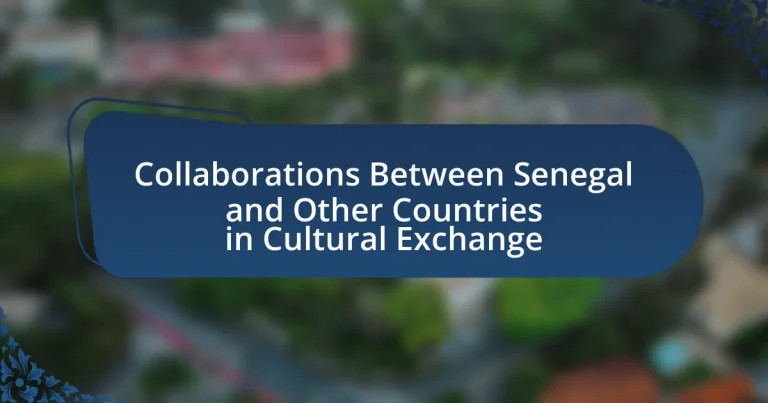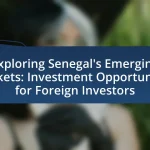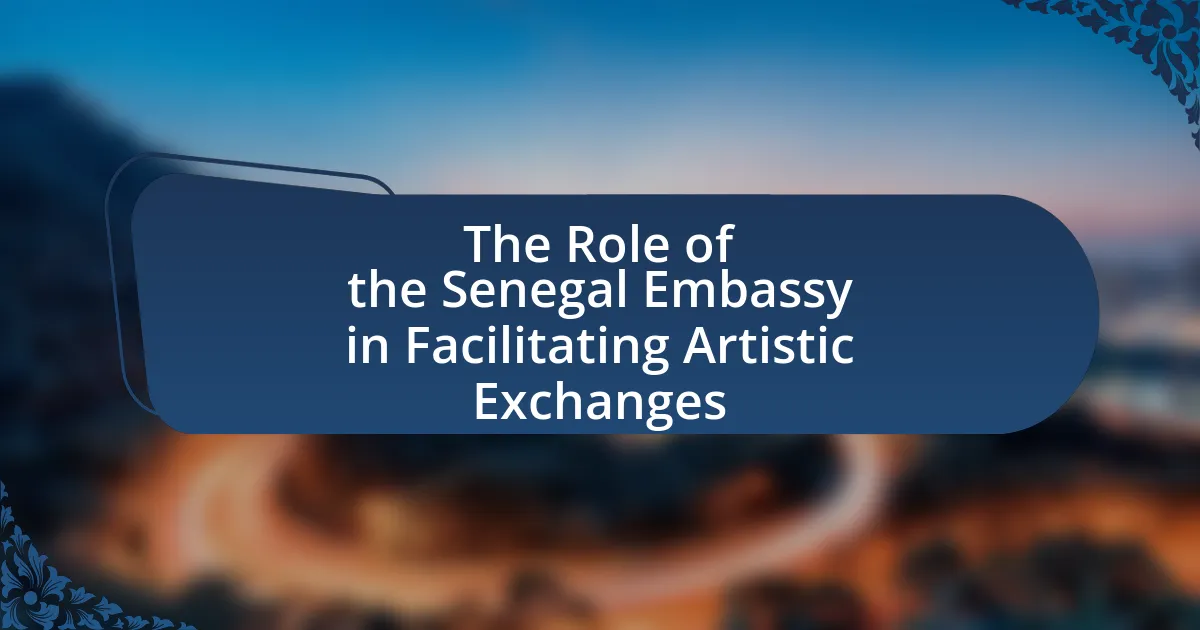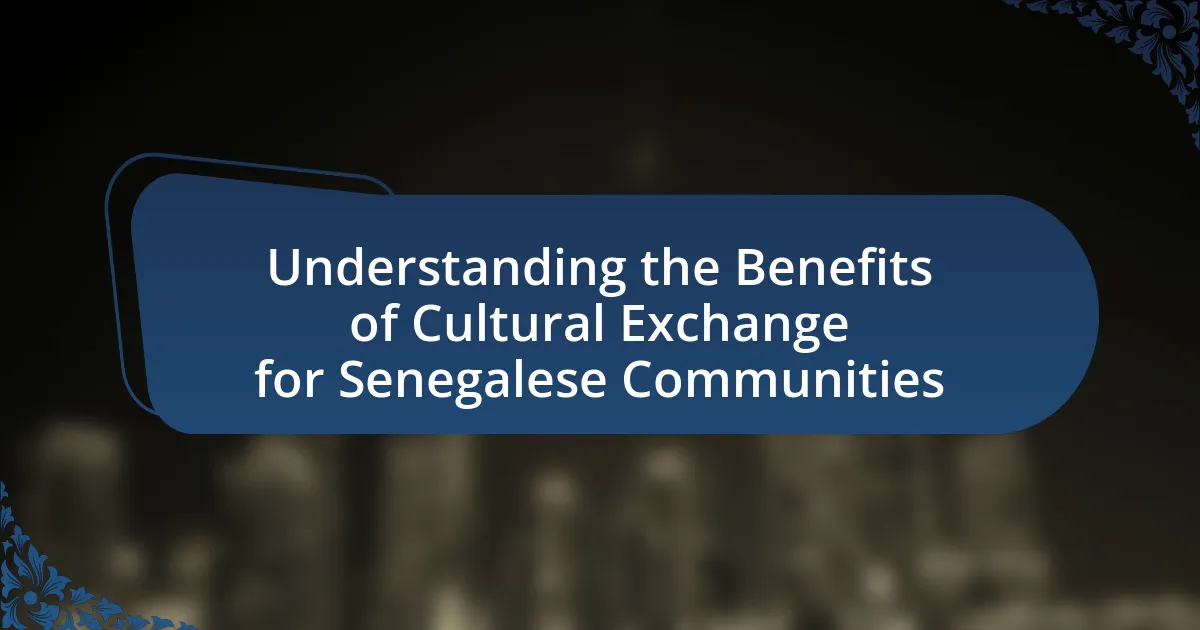The article focuses on collaborations between Senegal and other countries in cultural exchange, highlighting key aspects such as artistic partnerships, educational programs, and heritage preservation initiatives. It examines how these collaborations enhance cultural understanding through the exchange of music, dance, cuisine, and traditional crafts, while also discussing their impact on local communities, economic growth, and tourism. The role of governmental and non-governmental organizations in facilitating these exchanges is emphasized, along with the historical contexts that shape current collaborations. Additionally, the article addresses challenges faced in cultural exchanges and suggests strategies for improving collaboration effectiveness, including the use of technology and community involvement.
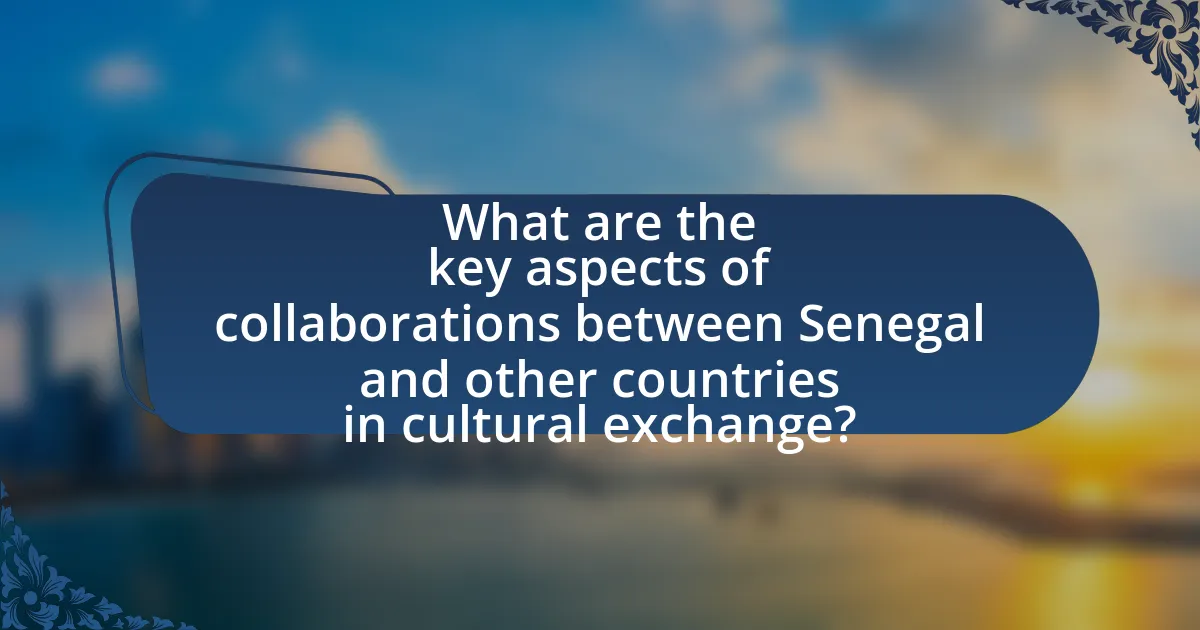
What are the key aspects of collaborations between Senegal and other countries in cultural exchange?
Key aspects of collaborations between Senegal and other countries in cultural exchange include artistic partnerships, educational programs, and heritage preservation initiatives. Senegal actively engages in cultural diplomacy, exemplified by its participation in international festivals and art exhibitions, which promote Senegalese music, dance, and visual arts globally. Educational exchanges, such as student and teacher programs, foster mutual understanding and knowledge sharing between Senegal and partner nations. Additionally, Senegal collaborates on heritage preservation projects, focusing on the conservation of historical sites and traditional practices, which enhances cultural appreciation and tourism. These collaborations are supported by agreements with various countries and international organizations, reinforcing Senegal’s commitment to cultural exchange.
How do these collaborations enhance cultural understanding?
Collaborations between Senegal and other countries enhance cultural understanding by facilitating the exchange of traditions, languages, and artistic expressions. These partnerships often involve joint cultural festivals, art exhibitions, and educational programs that showcase Senegalese culture while also incorporating elements from partner nations. For instance, the Senegalese government has engaged in cultural exchanges with France, leading to increased appreciation of Senegalese music and dance in French communities, as evidenced by events like the Dakar Biennale, which attracts international artists and audiences. Such interactions promote dialogue and foster mutual respect, ultimately enriching the cultural landscape of all involved parties.
What specific cultural elements are exchanged between Senegal and partner countries?
Senegal exchanges various cultural elements with partner countries, including music, dance, cuisine, and traditional crafts. For instance, Senegal’s vibrant music genres, such as mbalax, have influenced and been influenced by international artists, fostering collaborations that blend local rhythms with global sounds. Additionally, Senegalese cuisine, characterized by dishes like thieboudienne, has gained popularity in other countries, leading to culinary exchanges and adaptations. Traditional crafts, such as weaving and pottery, are also shared, showcasing Senegal’s artisanal skills while incorporating techniques from partner nations. These exchanges enhance cultural understanding and appreciation, as evidenced by numerous cultural festivals and collaborative art projects that celebrate this diversity.
How do these exchanges impact local communities in Senegal?
Cultural exchanges significantly enhance local communities in Senegal by fostering economic growth, social cohesion, and cultural enrichment. These exchanges often lead to increased tourism, which boosts local businesses and creates job opportunities. For instance, the collaboration with countries like France and the United States has resulted in cultural festivals that attract visitors, thereby generating revenue for local artisans and vendors. Additionally, these interactions promote the sharing of knowledge and skills, enriching the local cultural landscape and encouraging community engagement. The impact is evident in the rise of community-led initiatives that celebrate Senegalese heritage while integrating diverse cultural influences, ultimately strengthening the social fabric of local communities.
What role do governmental and non-governmental organizations play in these collaborations?
Governmental and non-governmental organizations play crucial roles in facilitating collaborations between Senegal and other countries in cultural exchange. These organizations often provide funding, resources, and expertise that enable cultural programs and initiatives to thrive. For instance, the Senegalese Ministry of Culture collaborates with international bodies like UNESCO to promote cultural heritage and artistic expression, which enhances global cultural dialogue. Additionally, NGOs such as the Senegalese Association for the Promotion of Culture work to connect local artists with international platforms, fostering cross-cultural understanding and collaboration. These efforts are supported by statistics indicating that cultural exchanges can increase tourism and economic growth, demonstrating the tangible benefits of such partnerships.
Which organizations are most active in promoting cultural exchange with Senegal?
The organizations most active in promoting cultural exchange with Senegal include the Alliance Française, the Goethe-Institut, and the British Council. The Alliance Française facilitates French language and cultural programs, enhancing ties between Senegal and France. The Goethe-Institut promotes German culture and language through various initiatives, fostering connections between Senegal and Germany. The British Council engages in educational and cultural projects that strengthen the relationship between Senegal and the United Kingdom. These organizations contribute significantly to cultural dialogue and exchange through their diverse programs and activities.
How do these organizations facilitate partnerships between Senegal and other nations?
Organizations facilitate partnerships between Senegal and other nations by promoting cultural exchange programs, trade agreements, and collaborative projects. For instance, the Senegalese government collaborates with international organizations like UNESCO to enhance cultural heritage preservation, which fosters mutual understanding and respect among nations. Additionally, initiatives such as the Senegalese Diaspora Network connect Senegalese expatriates with local communities, encouraging knowledge transfer and investment opportunities. These efforts are supported by statistics showing that cultural exchanges can increase tourism and economic growth, thereby solidifying Senegal’s international relationships.
What are the historical contexts of Senegal’s cultural exchanges with other countries?
Senegal’s cultural exchanges with other countries have historically been shaped by its strategic geographic location, colonial history, and the influence of trade routes. The country, situated along the Atlantic coast of West Africa, served as a significant point for transatlantic trade, particularly during the slave trade era, which facilitated cultural interactions between African, European, and American cultures.
During the colonial period, French colonization introduced European cultural elements, which blended with local traditions, leading to a unique cultural synthesis. Post-independence, Senegal actively engaged in cultural diplomacy, promoting its rich heritage through festivals, art, and music, such as the Dakar Biennale, which attracts international artists and fosters global cultural dialogue.
Additionally, Senegal’s membership in organizations like the African Union and the Francophonie has further enhanced its cultural exchanges, allowing for collaboration with various countries in areas such as literature, music, and visual arts. These historical contexts illustrate how Senegal’s cultural exchanges have evolved through trade, colonization, and international cooperation.
How have historical events shaped current cultural collaborations?
Historical events have significantly influenced current cultural collaborations by establishing foundational relationships and shared experiences among nations. For instance, the colonial history of Senegal, particularly under French rule, created a complex interplay of cultural exchange that persists today. This historical context has led to ongoing collaborations in arts, music, and education, as seen in initiatives like the Festival International de Jazz de Saint-Louis, which celebrates both local and international artists. Additionally, Senegal’s role in the African Renaissance movement has fostered partnerships with various countries, promoting cultural dialogue and exchange programs that reflect shared histories and aspirations. These collaborations are rooted in the historical ties formed through trade, migration, and colonialism, which continue to shape the cultural landscape and collaborative efforts in the present day.
What lessons can be learned from past cultural exchanges involving Senegal?
Past cultural exchanges involving Senegal highlight the importance of mutual respect and understanding in fostering collaboration. These exchanges, such as the Senegalese participation in the Festival of African Arts in Dakar in 1966, demonstrated how cultural dialogue can enhance national identity while promoting global awareness. The successful integration of diverse artistic expressions, like music and dance, illustrates that cultural exchanges can lead to economic benefits through tourism and international partnerships. Furthermore, the collaboration between Senegal and France in the realm of literature and education has shown that shared cultural heritage can strengthen diplomatic ties and promote social cohesion.
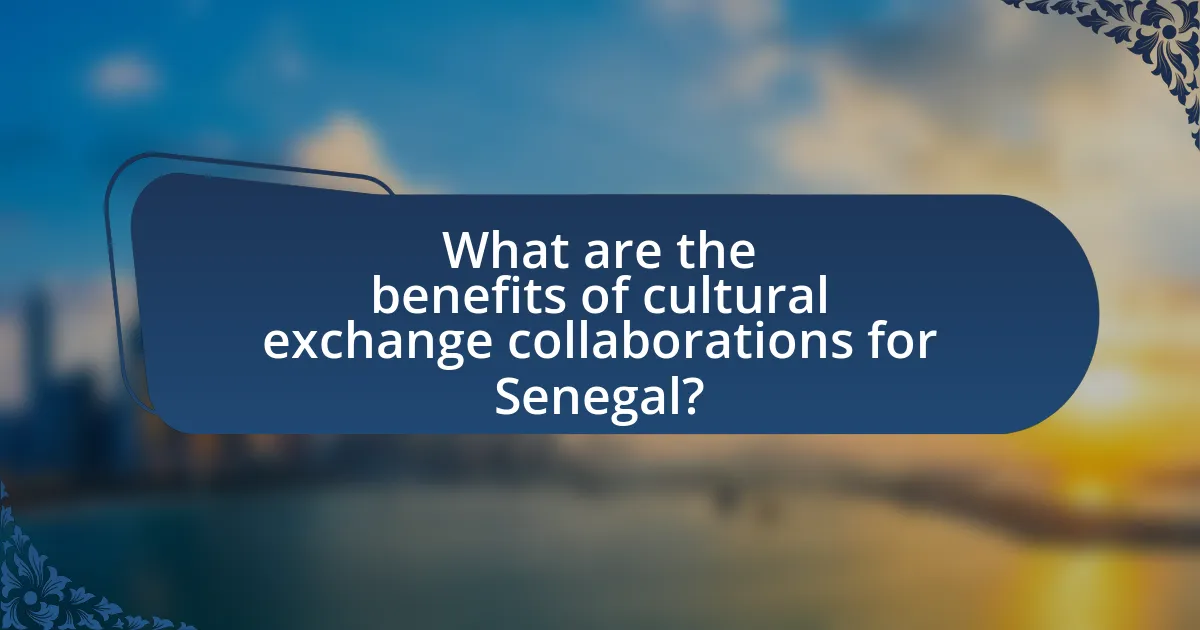
What are the benefits of cultural exchange collaborations for Senegal?
Cultural exchange collaborations benefit Senegal by enhancing its cultural diversity, fostering economic growth, and promoting international understanding. These collaborations allow Senegal to showcase its rich heritage, such as music and art, which can attract tourism and investment. For instance, the annual Dakar Biennale, a significant cultural event, draws international artists and audiences, boosting local economies. Additionally, partnerships with foreign institutions facilitate knowledge transfer and skill development, contributing to the professional growth of Senegalese artists and cultural practitioners. This exchange not only enriches Senegal’s cultural landscape but also strengthens diplomatic ties, promoting peace and cooperation on a global scale.
How do these collaborations contribute to Senegal’s cultural identity?
Collaborations between Senegal and other countries significantly enhance Senegal’s cultural identity by facilitating the exchange of artistic expressions, traditions, and knowledge. These partnerships allow Senegalese artists to showcase their work on international platforms, thereby promoting local culture globally. For instance, initiatives like the Dakar Biennale attract international artists and audiences, fostering cross-cultural dialogue and appreciation. This exposure not only enriches Senegal’s artistic landscape but also reinforces national pride and cultural heritage, as seen in the revival of traditional crafts and music influenced by global interactions.
What are the effects of cultural exchange on Senegalese art and music?
Cultural exchange significantly enriches Senegalese art and music by introducing diverse influences and fostering innovation. This interaction has led to the incorporation of various musical styles, such as jazz, hip-hop, and reggae, into traditional Senegalese genres like mbalax, creating a unique fusion that resonates with both local and global audiences. For instance, the collaboration between Senegalese musicians and international artists has resulted in acclaimed projects, such as Youssou N’Dour’s work with Peter Gabriel, which showcases the blending of African rhythms with Western musical elements. Additionally, cultural exchange initiatives, such as art exhibitions and music festivals, promote cross-cultural dialogue and appreciation, further enhancing the visibility and evolution of Senegalese artistic expressions on the world stage.
How do these exchanges influence language preservation in Senegal?
Cultural exchanges between Senegal and other countries significantly influence language preservation by promoting the use and appreciation of local languages in international contexts. These exchanges often involve collaborative projects, educational programs, and artistic initiatives that highlight Senegal’s linguistic diversity, particularly languages like Wolof, Pulaar, and Serer. For instance, partnerships with foreign universities and cultural institutions facilitate language courses and workshops, thereby enhancing the visibility and usage of these languages. Additionally, international festivals and events that showcase Senegalese culture encourage the participation of local artists and speakers, reinforcing the importance of language in cultural identity. This active engagement helps to sustain and revitalize local languages, ensuring their continued relevance in a globalized world.
What economic benefits arise from cultural exchange collaborations?
Cultural exchange collaborations generate significant economic benefits by enhancing tourism, fostering trade, and creating job opportunities. For instance, increased cultural interactions often lead to a rise in tourism, as visitors are attracted to cultural festivals, art exhibitions, and culinary experiences. According to the United Nations World Tourism Organization, cultural tourism accounts for approximately 40% of global tourism, highlighting its economic impact. Additionally, these collaborations can stimulate trade by promoting local artisans and products on an international scale, thereby increasing exports. Furthermore, cultural exchange initiatives often lead to job creation in sectors such as hospitality, arts, and education, contributing to overall economic growth.
How do cultural exchanges promote tourism in Senegal?
Cultural exchanges promote tourism in Senegal by enhancing the country’s global visibility and attracting international visitors. These exchanges facilitate the sharing of Senegalese art, music, and traditions, which resonate with diverse audiences and encourage travel to experience the culture firsthand. For instance, events like the Dakar Biennale showcase local artists and draw tourists interested in contemporary African art, significantly boosting visitor numbers. Additionally, partnerships with foreign cultural institutions often lead to festivals and workshops that highlight Senegal’s rich heritage, further stimulating interest and tourism.
What role does cultural exchange play in attracting foreign investment?
Cultural exchange plays a significant role in attracting foreign investment by fostering mutual understanding and trust between countries. When nations engage in cultural exchange, they create an environment that encourages collaboration and reduces perceived risks for investors. For instance, Senegal’s cultural initiatives, such as art festivals and educational partnerships, enhance its global image and showcase its potential as a stable investment destination. According to a report by the World Bank, countries that actively promote cultural diplomacy often see a 20% increase in foreign direct investment, as investors are more likely to engage in markets where they feel culturally connected and informed.
How do cultural exchanges foster innovation and creativity in Senegal?
Cultural exchanges foster innovation and creativity in Senegal by facilitating the sharing of diverse ideas, practices, and artistic expressions. These exchanges enable Senegalese artists, entrepreneurs, and thinkers to collaborate with international counterparts, leading to the fusion of traditional Senegalese culture with global influences. For instance, programs like the “Festival International de Jazz de Dakar” attract international musicians, which not only enriches local music scenes but also inspires new genres and collaborative projects. Furthermore, initiatives such as the “Cultural Cooperation Agreement” between Senegal and France promote educational exchanges, allowing Senegalese students to gain exposure to different methodologies and perspectives, thereby enhancing their creative problem-solving skills. This cross-pollination of ideas ultimately drives innovation in various sectors, including arts, technology, and business, contributing to Senegal’s cultural and economic development.
What are some examples of innovative projects resulting from these collaborations?
Innovative projects resulting from collaborations between Senegal and other countries in cultural exchange include the “Dakar Biennale,” an international art exhibition that showcases contemporary African art and fosters dialogue among artists globally. Another example is the “Senegalese-French Cultural Cooperation,” which has led to the establishment of cultural centers promoting Senegalese literature and music in France. Additionally, the “African Film Festival” in collaboration with various international partners highlights African cinema and provides a platform for filmmakers to share their work with a broader audience. These projects exemplify the successful blending of cultural influences and the promotion of Senegalese heritage on a global stage.
How do cultural exchanges inspire local entrepreneurs in Senegal?
Cultural exchanges inspire local entrepreneurs in Senegal by providing them with new ideas, skills, and networks that enhance their business opportunities. These exchanges often involve collaboration with international partners, exposing Senegalese entrepreneurs to diverse business practices and innovative approaches. For instance, programs like the Senegalese-American Cultural Exchange have facilitated workshops and mentorships, allowing local entrepreneurs to learn about marketing strategies and product development from their American counterparts. This exposure not only fosters creativity but also encourages the adoption of best practices, ultimately leading to increased competitiveness in both local and global markets.
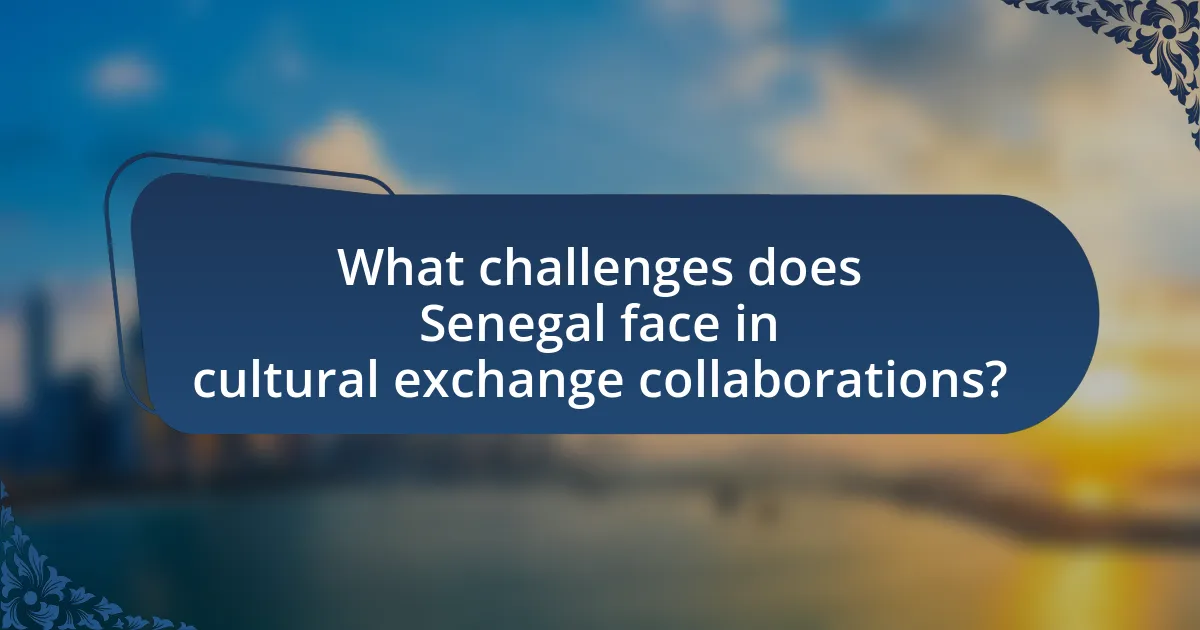
What challenges does Senegal face in cultural exchange collaborations?
Senegal faces several challenges in cultural exchange collaborations, including limited funding, bureaucratic hurdles, and language barriers. Limited funding restricts the scope and scale of cultural projects, making it difficult to sustain long-term collaborations. Bureaucratic hurdles often slow down the process of establishing partnerships, as navigating governmental regulations can be complex. Additionally, language barriers hinder effective communication and collaboration with international partners, as French is the official language, while many potential collaborators may not be fluent. These factors collectively impede the potential for fruitful cultural exchanges.
What are the common obstacles to successful cultural exchanges?
Common obstacles to successful cultural exchanges include language barriers, differing cultural norms, and lack of mutual understanding. Language barriers hinder effective communication, making it difficult for participants to share ideas and experiences. Differing cultural norms can lead to misunderstandings or misinterpretations of behaviors and practices, which may create discomfort or conflict. Additionally, a lack of mutual understanding can result from insufficient preparation or research about the other culture, limiting the depth and quality of the exchange. These factors collectively impede the potential for meaningful interactions and learning opportunities in cultural exchanges.
How do language barriers affect cultural collaboration efforts?
Language barriers significantly hinder cultural collaboration efforts by impeding effective communication and mutual understanding among participants. When individuals from different linguistic backgrounds attempt to collaborate, misunderstandings can arise, leading to misinterpretations of cultural nuances and intentions. For instance, a study by the European Commission found that 56% of Europeans believe language barriers prevent them from engaging fully in cultural exchanges. This lack of clarity can result in diminished trust and reduced willingness to share cultural practices, ultimately stifling the potential for meaningful collaboration.
What are the financial constraints faced by organizations in Senegal?
Organizations in Senegal face several financial constraints, primarily including limited access to credit, high interest rates, and inadequate funding from government sources. Limited access to credit restricts organizations’ ability to invest in growth and operational needs, as many financial institutions are hesitant to lend to businesses perceived as high-risk. High interest rates further exacerbate this issue, making borrowing costly and unsustainable for many organizations. Additionally, government funding is often insufficient and inconsistent, which hampers the ability of organizations to plan long-term projects or collaborations, particularly in cultural exchange initiatives. These financial challenges significantly impact the operational capacity and sustainability of organizations in Senegal.
How can Senegal overcome these challenges in cultural exchange?
Senegal can overcome challenges in cultural exchange by fostering partnerships with international organizations and leveraging technology for virtual exchanges. Establishing collaborations with entities like UNESCO can enhance cultural dialogue and provide resources for cultural programs. Additionally, utilizing digital platforms can facilitate remote interactions, allowing Senegalese artists and cultural practitioners to connect with global audiences, thereby promoting cultural understanding and exchange. For instance, the Senegalese government has previously engaged in initiatives that promote cultural festivals and art exhibitions, which have successfully attracted international participation, demonstrating the effectiveness of such collaborations.
What strategies can be implemented to enhance collaboration effectiveness?
To enhance collaboration effectiveness, establishing clear communication channels is essential. Effective communication fosters understanding and alignment among team members, which is crucial in cross-cultural exchanges. Research indicates that organizations with strong communication practices experience 25% higher productivity (McKinsey & Company). Additionally, implementing regular feedback mechanisms allows for continuous improvement and adaptation, ensuring that all parties remain engaged and informed. Utilizing collaborative technologies, such as shared platforms and tools, can also streamline processes and facilitate real-time collaboration, further enhancing the effectiveness of cultural exchanges between Senegal and other countries.
How can technology be leveraged to improve cultural exchanges?
Technology can be leveraged to improve cultural exchanges by facilitating real-time communication and access to diverse cultural content. For instance, platforms like social media and video conferencing tools enable individuals from different countries, including Senegal, to engage in discussions, share experiences, and collaborate on projects without geographical barriers. Additionally, digital archives and online museums provide access to cultural artifacts and educational resources, allowing for a deeper understanding of various cultures. Research indicates that online cultural initiatives can increase participation in cultural exchanges by up to 60%, demonstrating the effectiveness of technology in fostering global connections and cultural appreciation.
What best practices can be adopted for successful cultural exchange collaborations?
Successful cultural exchange collaborations can be achieved by establishing clear communication, mutual respect, and shared goals among participants. Clear communication ensures that all parties understand each other’s cultural contexts and expectations, which minimizes misunderstandings. Mutual respect fosters an environment where diverse perspectives are valued, enhancing collaboration. Shared goals align the efforts of all participants, creating a unified direction for the exchange. For instance, the Senegalese cultural exchange programs with France have thrived due to these practices, leading to enriched artistic collaborations and increased cultural awareness.
What role does community involvement play in successful exchanges?
Community involvement is crucial for successful exchanges as it fosters trust, enhances participation, and ensures cultural relevance. Engaging local communities allows for the identification of shared values and interests, which strengthens the collaborative process. For instance, in cultural exchanges between Senegal and other countries, community input can lead to more authentic representations of cultural practices, thereby increasing the effectiveness of the exchange. Research indicates that programs with strong community engagement report higher satisfaction rates and better outcomes, as seen in various cultural initiatives across Senegal that prioritize local voices in planning and execution.
How can feedback mechanisms improve future cultural collaborations?
Feedback mechanisms can enhance future cultural collaborations by facilitating open communication and continuous improvement. These mechanisms allow participants to share their experiences, insights, and suggestions, which can lead to more effective strategies and practices in cross-cultural projects. For instance, a study by the International Journal of Cultural Policy highlights that structured feedback processes can identify cultural misunderstandings and areas for growth, ultimately fostering stronger partnerships. By implementing regular feedback sessions, collaborators can adapt their approaches based on real-time input, ensuring that cultural exchanges are more relevant and impactful.
